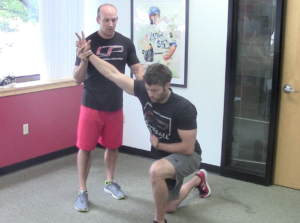
Destroying Baseball Dogma: Installment 1
Today, I’m going to kick off a new series about common myths from the baseball world. I’ll tackle one of these each month. In this first installment, we’re going to have some fun with this quote that I hear all too often:
“Guys are working too hard in the off-season,
and all this strength training is leading to injuries.”
I’ve heard this muttered hundreds of times, but this is this quote by Lou Piniella in the NY Times in 2013 stands out for me:
“The season is so long now and so strenuous, you need to rest your body for two-three months after it’s over,” said Sweet Lou. “But today, these players all have their personal trainers and they work out all winter and put on more muscle. When I played, we didn’t have a weight room or a strength coach and everybody took the team bus to the ballpark. We never heard of an oblique. Now guys are going out on their own, five or six hours before the game, going right to the batting cages and taking hundreds of swings a day. It’s overdone. The body can’t take it. If you ask me, that’s where all these oblique injuries are coming from.
I’m going to respond to this in bullet point fashion, as I think there are a lot of gems in here:
1. You’ll be surprised to know that I partially agree with Piniella on a few different fronts. First, the season is absurdly long. Guys may play 200 games in 230 days – with a lot of travel mixed in – and that makes it incredibly hard to maintain strength, tissue quality, and mobility. Interestingly, though, a lot more injuries occur at the beginning of a season than at the end. It makes you wonder if some guys are showing up unprepared and then benefiting from the adherence the team environment forces.
Second, setting the lazy off-season guys aside, there are a lot of players who are doing absolutely idiotic stuff with their training. As recently as a few years ago, a few teams were still recommending P90X to MLB players for off-season conditioning. I’m not making that up. How can we say strength training is the problem if most organizations still haven’t even made it a priority?
Third, guys getting bigger and stronger is leading to injuries…but doing so in an indirect way. You see, average body weight in Major League Baseball increased by 12% from 1990 to 2010; this time period parallels the rise in popularity of strength training. With the increase has come a huge increase in average fastball velocity, too – especially over the past 6-7 years. And, the aforementioned body weight study also showed that offensive leaders were more likely to be heavier than their “normal” MLB counterparts. Obviously, the steroid era played into this, but the message doesn’t change: being stronger increases your likelihood of success – even if it means you are playing with fire with respect to injuries. Swinging quicker, throwing harder, and running faster will increase your likelihood of injury – regardless of whether you strength trained to get to that point in the first place.
The alternative, unfortunately, is to throw 88mph or have subpar bat speed – neither of which will help you compete in the modern game. At the highest level, sports will always be a balancing act between high performance and injury risk. To this point, I’d also subjectively note that most of the guys who have wound up with injuries this spring were not massive dudes; I’d argue that they really weren’t that strong or heavy.
2. With respect to the comment about taking 2-3 months off at the end of the season, one has to really do the math on this to realize how silly it would be. The big league season ends in early October for most teams, whereas playoff teams will play all the way through the month of October. If a player takes off all of October, November, and December, he wouldn’t do anything until January 1. If he make the playoffs, he wouldn’t do anything until (potentially) February 1. If players report in mid-February, that would give them 2-6 weeks to prepare.
If you think that’s enough, good luck dealing with the media scrutiny that comes when a load of the players are on the disabled list, and all the pitchers’ fastball velocities are down.
I’d also ask: is it healthy for anyone to take 2-3 months off from exercise altogether? Let’s just make them obese in hopes of cutting back on our oblique strains!
3. I think it’s important to recognize that not all lifting is created equal. The problems usually stem from incorrect technique, poor exercise selection, excessive loading, or a number of other common mistakes. If one athlete burns himself on a cup of coffee because he wasn’t careful with how he prepared or drank it, do you vilify coffee for an entire team? Of course not! So, why vilify strength training because there are some idiots out there applying it incorrectly?
Taking it a step further, lifting sometimes “displaces” other important components of a successful training program – because lifting heavy stuff is “sexier” to many athletes. You simply can’t lift at the exclusion of other key physical preparation strategies; it has to complement them.

4. To build on the last point, in many cases, lifting may become a problem because it’s “ingraining” poor movement quality. As Gray Cook has often said, “you can’t put fitness on top of dysfunction.”
The key word here is “fitness.” Many things – not just lifting – could bring these issues to threshold. Throwing, swinging, and sprinting could all bring movement flaws to a painful threshold, too. However, unlike strength training, these approaches can’t be used to correct the fundamental problem – even if they’re implemented perfectly.
[bctt tweet=”General training can correct movement dysfunction, whereas specific training usually exacerbates it.”]
5. Most obviously, if lifting was really the only problem, wouldn’t we see a lot more guys getting hurt while lifting? Truth be told, the injury rates in strength training participation are remarkably low – even with crappy programming.
Bringing all these points together, the truth is that injuries have always been, are, and will continue to be multi-factorial. Short of traumatic instances like being hit by a pitch, or fouling a ball off your foot, everything is something that has built for days, weeks, months, or years. There are far too many different variables involved that have constantly changed over the past few decades to truly determine what causes injuries, so it’s short-sighted to make strength training the scapegoat – especially when we know the value it has in enhancing performance, reducing injury risk, and facilitating injury rehabilitation.
Destroying Baseball Dogma is one reason we introduced our Cressey Sports Performance Elite Baseball Mentorships; we want to teach baseball coaches, strength and conditioning professionals, and rehabilitation specialists to learn more about how to best prepare players to handle the unique demands involved in baseball. Our next Upper Extremity course will be December 18-20, 2016; to learn more, click here.




